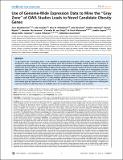| dc.contributor.author | Peltonen, Leena | |
| dc.contributor.author | Naukkarinen, Jussi | |
| dc.contributor.author | Surakka, Ida | |
| dc.contributor.author | Pietiläinen, Kirsi H. | |
| dc.contributor.author | Rissanen, Aila | |
| dc.contributor.author | Salomaa, Veikko | |
| dc.contributor.author | Ripatti, Samuli | |
| dc.contributor.author | Yki-Järvinen, Hannele | |
| dc.contributor.author | van Duijn, Cornelia M. | |
| dc.contributor.author | Wichmann, H.-Erich | |
| dc.contributor.author | Kaprio, Jaakko | |
| dc.contributor.author | Taskinen, Marja-Riitta | |
| dc.contributor.author | ENGAGE Consortium | |
| dc.date.accessioned | 2011-01-06T22:17:58Z | |
| dc.date.available | 2011-01-06T22:17:58Z | |
| dc.date.issued | 2010-06 | |
| dc.date.submitted | 2009-11 | |
| dc.identifier.issn | 1553-7404 | |
| dc.identifier.issn | 1553-7390 | |
| dc.identifier.uri | http://hdl.handle.net/1721.1/60388 | |
| dc.description.abstract | To get beyond the “low-hanging fruits” so far identified by genome-wide association (GWA) studies, new methods must be developed in order to discover the numerous remaining genes that estimates of heritability indicate should be contributing to complex human phenotypes, such as obesity. Here we describe a novel integrative method for complex disease gene identification utilizing both genome-wide transcript profiling of adipose tissue samples and consequent analysis of genome-wide association data generated in large SNP scans. We infer causality of genes with obesity by employing a unique set of monozygotic twin pairs discordant for BMI (n = 13 pairs, age 24–28 years, 15.4 kg mean weight difference) and contrast the transcript profiles with those from a larger sample of non-related adult individuals (N = 77). Using this approach, we were able to identify 27 genes with possibly causal roles in determining the degree of human adiposity. Testing for association of SNP variants in these 27 genes in the population samples of the large ENGAGE consortium (N = 21,000) revealed a significant deviation of P-values from the expected (P = 4×10−4). A total of 13 genes contained SNPs nominally associated with BMI. The top finding was blood coagulation factor F13A1 identified as a novel obesity gene also replicated in a second GWA set of ~2,000 individuals. This study presents a new approach to utilizing gene expression studies for informing choice of candidate genes for complex human phenotypes, such as obesity. | en_US |
| dc.description.sponsorship | Seventh Framework Programme (European Commission) (FP7/2007-2013) | en_US |
| dc.description.sponsorship | ENGAGE Consortium (grant agreement HEALTH-F4-2007-201413) | en_US |
| dc.language.iso | en_US | |
| dc.publisher | Public Library of Science | en_US |
| dc.relation.isversionof | http://dx.doi.org/10.1371/journal.pgen.1000976 | en_US |
| dc.rights | Creative Commons Attribution | en_US |
| dc.rights.uri | http://creativecommons.org/licenses/by/2.5/ | en_US |
| dc.source | PLoS | en_US |
| dc.title | Use of Genome-Wide Expression Data to Mine the "Gray Zone" of GWA Studies Leads to Novel Candidate Obesity Genes | en_US |
| dc.type | Article | en_US |
| dc.identifier.citation | Naukkarinen, Jussi et al. “Use of Genome-Wide Expression Data to Mine the “Gray Zone” of GWA Studies Leads to Novel Candidate Obesity Genes.” PLoS Genet 6.6 (2010): e1000976. | en_US |
| dc.contributor.department | Broad Institute of MIT and Harvard | en_US |
| dc.contributor.approver | Peltonen, Leena | |
| dc.contributor.mitauthor | Peltonen, Leena | |
| dc.relation.journal | PLoS Genetics | en_US |
| dc.eprint.version | Final published version | en_US |
| dc.type.uri | http://purl.org/eprint/type/JournalArticle | en_US |
| eprint.status | http://purl.org/eprint/status/PeerReviewed | en_US |
| dspace.orderedauthors | Naukkarinen, Jussi; Surakka, Ida; Pietiläinen, Kirsi H.; Rissanen, Aila; Salomaa, Veikko; Ripatti, Samuli; Yki-Järvinen, Hannele; van Duijn, Cornelia M.; Wichmann, H.-Erich; Kaprio, Jaakko; Taskinen, Marja-Riitta; Peltonen, Leena | en |
| mit.license | PUBLISHER_CC | en_US |
| mit.metadata.status | Complete | |
